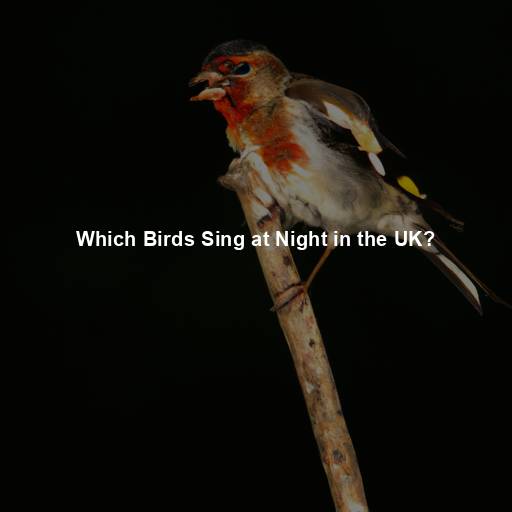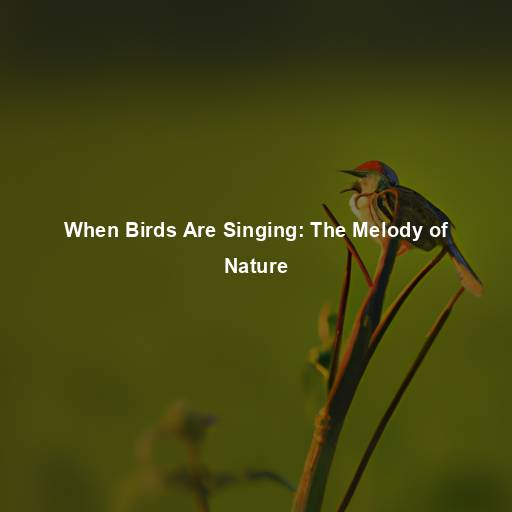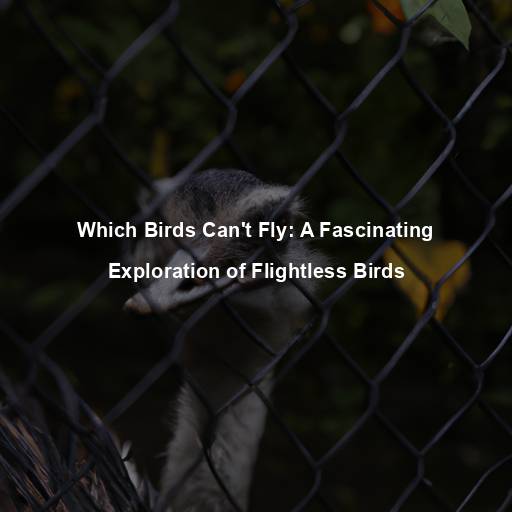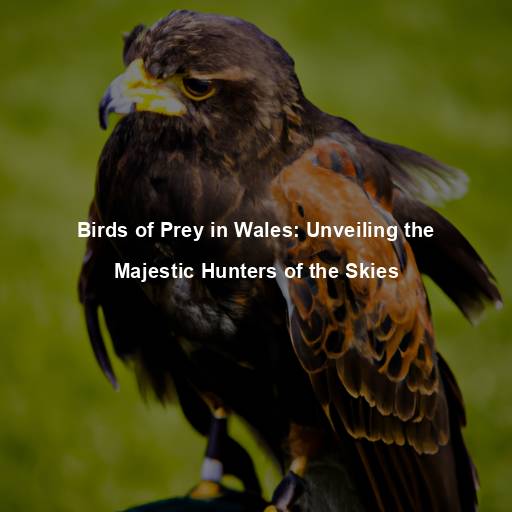Which Birds Sing at Night in the UK?
Last Updated on November 3, 2023 by Evan
Contents [hide]
- 1 Understanding Nocturnal Birds in the UK
- 2 The Nightingale: A Vocal Virtuoso
- 3 The Charming Chorus of Warblers
- 4 Owls: The Silent Hunters With Haunting Calls
- 5 The Enchanting Night Symphony
- 6 Other Nocturnal Avian Delights
- 7 The Importance of Nighttime Birds
- 8 Embrace the Nocturnal Serenade
- 9 The Chorus of Waterbirds
- 10 Appreciating the Nighttime Avian Symphony
- 11 FAQs – Which Birds Sing at Night in the UK?
- 11.1 What are nocturnal bird species commonly found in the UK?
- 11.2 Why do birds sing at night?
- 11.3 How can I identify the nocturnal bird songs I hear at night?
- 11.4 Are all nocturnal bird songs loud and distinctive?
- 11.5 Are there certain times when nocturnal birds are most active?
- 11.6 Can the presence of artificial lighting affect nocturnal bird behavior?
Understanding Nocturnal Birds in the UK
Step into a mysterious realm where darkness and melody intertwine, and discover a captivating subset of avian species that defy the boundaries of time. While we often associate birdsong with the dawn chorus, there exists a hidden symphony that takes flight under the cover of night. In the enchanting United Kingdom, a chorus of nocturnal birds breaks the silence, their unique adaptations enabling them to navigate and communicate under the veil of darkness. Join us as we embark on a journey to unravel the secrets of these feathered virtuosos and reveal the magical ambiance they create long after the sun has set.
The Nightingale: A Vocal Virtuoso
The Nightingale’s Melodious Serenade
One of the most renowned songsters of the night is the nightingale (Luscinia megarhynchos). With its vibrant and melodic song, the nightingale has captivated the hearts of poets and musicians throughout history. This small, unassuming bird possesses a remarkable vocal range and can produce a chorus of over 1,000 different notes. Its song is often described as rich, flute-like, and filled with complex trills and warbles.
The Nightingale’s Preferred Habitat
In the UK, nightingales can mainly be found in the southern and eastern parts of the country, favoring dense thickets, woodlands, and scrubby areas. These birds typically arrive in the UK from their wintering grounds in sub-Saharan Africa, gracing us with their enchanting melodies from late April to early June. Their songs are most prominent during the breeding season when male nightingales serenade to attract mates and establish territories.
The Thrush Nightingale: A Rare Encounter
Within the vast expanse of the United Kingdom’s avian population, a hidden gem exists in the form of the elusive thrush nightingale. Shrouded in mystery, this distant cousin of the common nightingale captivates with its enchanting song, whispered like a delicate flute. While not as commonly encountered, the thrush nightingale graces selected regions in the east of England during its migratory journey, leaving birdwatchers and nature enthusiasts spellbound during the months of May and June.
The Charming Chorus of Warblers
The Blackcap: A Musical Marvel
Step into the enchanting world of the blackcap, a charmer of the UK’s nocturnal symphony. With its petite frame and captivating voice, this feathered troubadour is known as the “northern nightingale”. The male blackcap serenades nature’s audience with a mesmerizing melody, blending a medley of harmonious notes and imitating the soundscape around it. Prepare to be captivated as this avian virtuoso weaves a tapestry of sound, leaving us in awe of its perplexing repertoire.
The Garden Warbler: A Hidden Gem
Amidst the flurry of avian artistry, there exists a true hidden gem – the unassuming garden warbler. While the dazzling talents of its counterparts steal the limelight, this feathered virtuoso serenades the twilight hours with an enchanting melody that reverberates through the very essence of nature. With a song that may not boast the elaborate theatrics of the nightingale or blackcap, the garden warbler captivates hearts with a humble yet mesmerizing warble, adding depth and intrigue to the nocturnal chorus. Those fortunate enough to roam the woodlands, gardens, and hedgerows of the UK may chance upon this perplexing songster, sparking wonder and awe at its untold bursts of melodic brilliance.
The Whitethroat: A Joyful Jumble
With its distinctive scratchy, jumbled song, the whitethroat (Sylvia communis) adds a unique element to the nocturnal symphony. This small warbler can be easily recognized by its whitish throat and striking features. Male whitethroats produce a lively and energetic song, often accompanied by a fluttery display flight. They inhabit a wide range of habitats, from grasslands to scrublands, delighting us with their musical prowess.
Owls: The Silent Hunters With Haunting Calls
The Tawny Owl: A Familiar Voice of the Night
Step into the enchanting world of night owls, where a captivating cast of birds takes center stage. Among them, the tawny owl (Strix aluco) holds a special place in the heart of the United Kingdom. With its resounding hoot, this feathered celebrity has become synonymous with the timeless soundscape of the British countryside. Delighting both day and night, male tawny owls grace woodlands and parklands, weaving an intricate symphony as they assert their territories and serenade their chosen companions.
The Barn Owl: A Ghostly Whisper in the Night
Another captivating nocturnal bird that graces the UK with its presence is the barn owl (Tyto alba). These magnificent birds are known for their ghostly appearance and silent flight. While they are primarily recognized for their exceptional hunting skills, barn owls also possess a unique vocalization. Their calls consist of eerie screeches, hisses, and raspy screams, which they use to communicate with their mates and offspring.
The Enchanting Night Symphony
As twilight blankets the land and the veil of darkness washes over, an unseen world awakens in the United Kingdom. A symphony of sound, crafted by the nocturnal birds, captures the essence of the night, perplexing us in its beauty. From the enchanting melodies sung by the nightingale and blackcap to the haunting calls of the tawny owl and barn owl, these feathered creatures embrace the magic of the nocturnal hours. In the heart of woodlands or while wandering through scrubby areas, even within the sanctuary of one’s garden, one cannot escape the allure of these captivating songs and calls.
The Nightjar’s Unique Vocalizations
Nestled amidst the enchanting forests and untamed heaths of the United Kingdom, an extraordinary creature holds court under the moonlit skies – the nightjar. A master of disguise, this enigmatic bird possesses a captivating plumage that effortlessly melds with the tapestry of its environment, rendering it invisible to the untrained eye. Yet, in the darkness, its melodious churring calls reverberate through the stillness, casting a bewitching spell upon all who dare to listen. As the male nightjar’s haunting song echoes across the realm, one can’t help but feel transported to a realm where reality and fantasy entwine in a mysterious dance.
The Nightjar’s Adaptations for Nighttime Life
Welcome to the mysterious world of the nightjar, a true enigma of the avian kingdom. With its mystical ability to blend seamlessly into its surroundings, this remarkable bird’s cloak of mottled feathers leaves even the keenest predator or unsuspecting prey perplexed and astounded. Equipped with extraordinary night vision, the nightjar gracefully maneuvers through the ebony sky, capturing its airborne insect quarry with unrivaled precision. As summer graces the lands of the UK, these elusive creatures make their fleeting appearance, favoring open habitats adorned with scattered trees, such as the enchanting heathlands and captivating moorlands.
Other Nocturnal Avian Delights
The Corncrake: A Rattling Call from the Grasslands
While not known for its melodious song, the corncrake (Crex crex) is a bird that makes its presence known during the night. This elusive species can be found in the grasslands of the UK, particularly in Scotland and the Western Isles. The male corncrake produces a distinctive rasping call that resembles the sound of a wooden rattle. This call is often associated with the arrival of spring and the breeding season.
The Woodcock: A Sudden Burst of Wings
The woodcock, scientifically known as Scolopax rusticola, is a mysterious creature that brings an air of excitement and wonder to the nighttime world. With their cleverly designed plumage, these medium-sized wading birds effortlessly blend into their woodland environments, making them masters of disguise. As the sun sets and darkness engulfs the landscape, the woodcocks take flight, captivating observers with their enchanting courtship rituals. Witnessing a male woodcock ascend into the sky, issuing a melodic chorus of high-pitched trills, only to swiftly descend with a resounding “roding” sound created by its wings, is an awe-inspiring experience that showcases the bird’s remarkable ability to adapt to the bewitching darkness.
The European Scops Owl: A Rare Nocturnal Encounter
The vast expanse of the UK might not necessarily be a sanctuary for a diverse owl population, but every now and then, a dash of magic fills the air as the European scops owl glides in during its migratory journey. These enchanting creatures, small in size yet large in enigma, carry a melodious symphony that pierces through the cloak of darkness. Their visits to the UK may be sporadic, but for those fortunate souls who stumble upon these elusive fliers, a sense of awe washes over them as they witness the mysterious dance of nocturnal rarity and fleeting beauty.
The Importance of Nighttime Birds
The enigmatic creatures that grace the moonlit skies of the United Kingdom hold within them a mesmerizing secret. They are the nocturnal birds, the guardians of balance, orchestrating a symphony amid the darkened landscapes. These avian marvels have harnessed the powers of heightened senses and vocal prowess, their melodious expressions weaving tales of courtship and territorial conquest, while shaping the very essence of the nocturnal soundtrack. In this intricate dance, they embody the enigmatic allure of the night, leaving us spellbound by their bursts of song and perplexed by their mysterious ways.
As we delve into the realm of these fascinating creatures of the night, a profound realization dawns upon us – the intricate tapestry of life unravels well beyond the confines of daylight. Observing their mysterious ways, we are compelled to contemplate the urgency of safeguarding their precious habitats, so that the symphony of the nocturnal world may thrive for generations to come. Let these enigmatic beings be our guides into the enigmatic realm of the night, embracing the enchantment that awaits.
Embrace the Nocturnal Serenade
As twilight descends upon the world, the air becomes a canvas for the enigmatic melodies of feathered artists. From the alluring serenades of the nightingale and blackcap to the haunting nocturnal calls of owls and the mesmerizing vocalizations of the nightjar, the nocturnal avian symphony in the UK unveils a tapestry of delightful perplexity that eagerly waits to be unraveled. Whether venturing into the depths of woodlands, traversing the enchanting heathlands, or simply indulging in the comfort of your own backyard, immersing oneself in the ethereal magic of the night brings forth an exquisite symphony performed by these extraordinary creatures. Within the nocturnal expanse lies a hidden trove of wonders, a burst of life waiting to captivate those who embrace its allure.
The Cuckoo’s Unusual Reproductive Strategy
The cuckoo (Cuculus canorus) is a fascinating bird with a unique reproductive strategy. Instead of building its own nest and raising its young, the female cuckoo lays her eggs in the nests of other bird species. Once hatched, the cuckoo chick pushes the host bird’s own eggs or young out of the nest, ensuring that it receives all the attention and resources from the unsuspecting foster parents. The male cuckoo, on the other hand, is known for its distinctive and repetitive “cuck-oo” call, which echoes through the woodlands during the breeding season.
The Cuckoo’s Arrival in the UK
Cuckoos are summer visitors to the UK, arriving in April and departing in July or August. These birds can be found in a variety of habitats, including woodlands, hedgerows, and farmlands. The male cuckoo’s call is often associated with the arrival of spring and is a welcomed sound for many bird enthusiasts. However, due to habitat loss and declining populations of host species, cuckoos are facing challenges in their breeding success.
The Chorus of Waterbirds
The Bittern: A Booming Call from the Marshes
The bittern (Botaurus stellaris) is a secretive heron-like bird that inhabits reed beds and marshes. While primarily active during the day, male bitterns produce a unique and mesmerizing call during the night. Their call, known as “booming,” is a deep, resonant sound that carries across the marshland. This vocalization is used by males to establish their territories and attract mates.
The Little Grebe: A Musical Duet
In the realm of aquatic avian wonders, behold the petite yet resolute Tachybaptus ruficollis, commonly known as the little grebe. Under the enigmatic cloak of darkness, this unassuming waterbird emerges with an inexplicable fervor. In a mesmerizing display of synchronicity, the enchanting duets of these creatures resonate through the night, an ethereal symphony where genders harmonize as equals. Their melodic calls, characterized by a cascade of whinnying notes known as “kweek-kweek,” reverberate in wetland havens across the United Kingdom, where lakes, ponds, and rivers bear witness to their presence with perplexing awe.
The Eurasian Coot: A Vocal Community
The enigmatic and captivating Eurasian coot, known scientifically as Fulica atra, gracefully navigates the serene waters of the United Kingdom, captivating the onlookers with its presence. Oscillating between the realms of daylight and darkness, these mysterious creatures unleash a symphony of peculiar calls that defy the boundaries of conventional communication. From their resonating nasal honks to the enigmatic grunts that reverberate through the waterways, the coots’ vocalizations exude an unparalleled sense of camaraderie and interconnectedness within their social circles. Truly, the coots’ enigmatic language serves as a mesmerizing spectacle, leaving observers in a state of delightful perplexity.
Appreciating the Nighttime Avian Symphony
The dark hours of the United Kingdom pulsate with an enigmatic symphony orchestrated by the whimsical creatures of the night. Among them, the nocturnal birds emerge as captivating enigmas, their voices and actions entangling the moonlit tapestry with complexities and mysteries unbeknownst to daylight dwellers. Whether it be the enigmatic reproductive tactics of the elusive cuckoo, the resounding calls of the bittern resonating through the ethereal serenity, or the harmonious duets of the diminutive little grebe, these avian marvels dazzle us with their uncanny adaptability and unyielding fortitude. A nocturnal realm teeming with splendor and vexation awaits those bold enough to unearth the secrets of these feathered enigmas.
As nature enthusiasts, it is our responsibility to appreciate and protect these nocturnal wonders. By preserving their habitats, reducing light pollution, and promoting conservation efforts, we can ensure that the nighttime avian symphony continues to enrich our lives and inspire future generations.
So, the next time you find yourself outdoors during the twilight hours, take a moment to listen. Immerse yourself in the enchanting melodies and calls of the nocturnal birds, and let their songs transport you to a world of wonder and beauty that thrives under the cover of darkness.
FAQs – Which Birds Sing at Night in the UK?
What are nocturnal bird species commonly found in the UK?
The night sky in the UK is alive with the enchanting melodies of our feathered friends. Among the nocturnal lineup are the mighty Tawny Owl, the elusive Nightjar, the soulful Nightingale, the mysterious Woodcock, and the charming Blackbird. These nocturnal troubadours have honed their vocal prowess under the cloak of darkness, serenading us with their otherworldly sounds during the bewitching hours.
Why do birds sing at night?
The captivating melodies of nocturnal birds pierce through the darkness, revealing the enigmatic power of their communication strategies. It is during the breeding season that male birds unleash their symphonies, not only to defend their sacred territories but also to court potential mates and outperform their fellow rivals. As the sun retreats, these avian maestros seize the opportune silence and exploit the minimal interference of background clamor to ensure their melodious declarations resonate with unparalleled intensity.
How can I identify the nocturnal bird songs I hear at night?
Identifying bird songs can be challenging, especially at night. To help identify nocturnal bird songs, it is best to familiarize yourself with the specific calls and songs of different bird species. There are various resources available, including bird field guides, apps, and online databases that provide audio recordings of bird songs. Additionally, joining local birding groups or participating in guided bird watching activities can help you learn to identify the songs of nocturnal birds.
Are all nocturnal bird songs loud and distinctive?
Contrary to popular belief, not all nocturnal bird melodies are rambunctious and instantly recognizable. In fact, these enigmatic creatures possess a mysterious range of melodies that span from gentle harmonies to peculiar sounds like grunts, clicks, or whistles. Deciphering these night-time symphonies requires us to attune our ears to intricate patterns, delicate notes, and elusive repetitions. Surprisingly, even the most delicate tunes hold the key to unravel the identity of these elusive avian artists.
Are there certain times when nocturnal birds are most active?
When the day fades into night and the first rays of sunlight start to kiss the horizon, a mysterious phenomenon takes place. It is during this enchanting twilight dance, known as the crepuscular phase, that a symphony of sounds emerges from the depths of darkness. Nocturnal birds, those marvelous creatures of the night, awaken from their slumber and fill the air with their melodious tunes. As the night progresses, their captivating melodies continue to resonate, captivating the hearts of those fortunate enough to bear witness to this captivating nocturnal serenade. Amongst these mesmerizing performers, the Nightjar stands out, their voices echoing through the nocturnal canvas, making the night come alive with their unique vocals.
Can the presence of artificial lighting affect nocturnal bird behavior?
Yes, artificial lighting can have an impact on the behavior of nocturnal birds. Bright lights can disrupt their natural circadian rhythms and interfere with their ability to navigate, forage, and communicate. Excessive lighting in certain habitats could deter nocturnal birds from inhabiting those areas, affecting their breeding and feeding patterns. It is important to be mindful of light pollution and try to minimize its impact on the environment to protect nocturnal bird species.







